Artists: Bridget Chappell and Debris Facility Pty Ltd
Gallery: Cool Change Contemporary
If you were there spinning the dial like an Ouroboros on Tuesday and hesitated somewhere between Triple M and Nova maybe you heard it. A shaky broadcast, the Amen break, mistransitions and meandering, unconcerned art chats: 4.Eva.FM holding you in illegally-occupied radiophonic space, you holding the broadcast between two ears on the corner of Barrack and Hay on Whadjuk Noongar land. During their residency, Debris Facility and Bridget Chappell transformed Cool Change Contemporary into a pirate radio station and studio, piggy-backing extension cables, taping vintage flyers on the wall and intermittently broadcasting on a handful of unallocated frequencies across a one kilometre radius. They invited ‘anyone with memories, desires, hot takes on WA rave histories and futures to visit and participate.’1
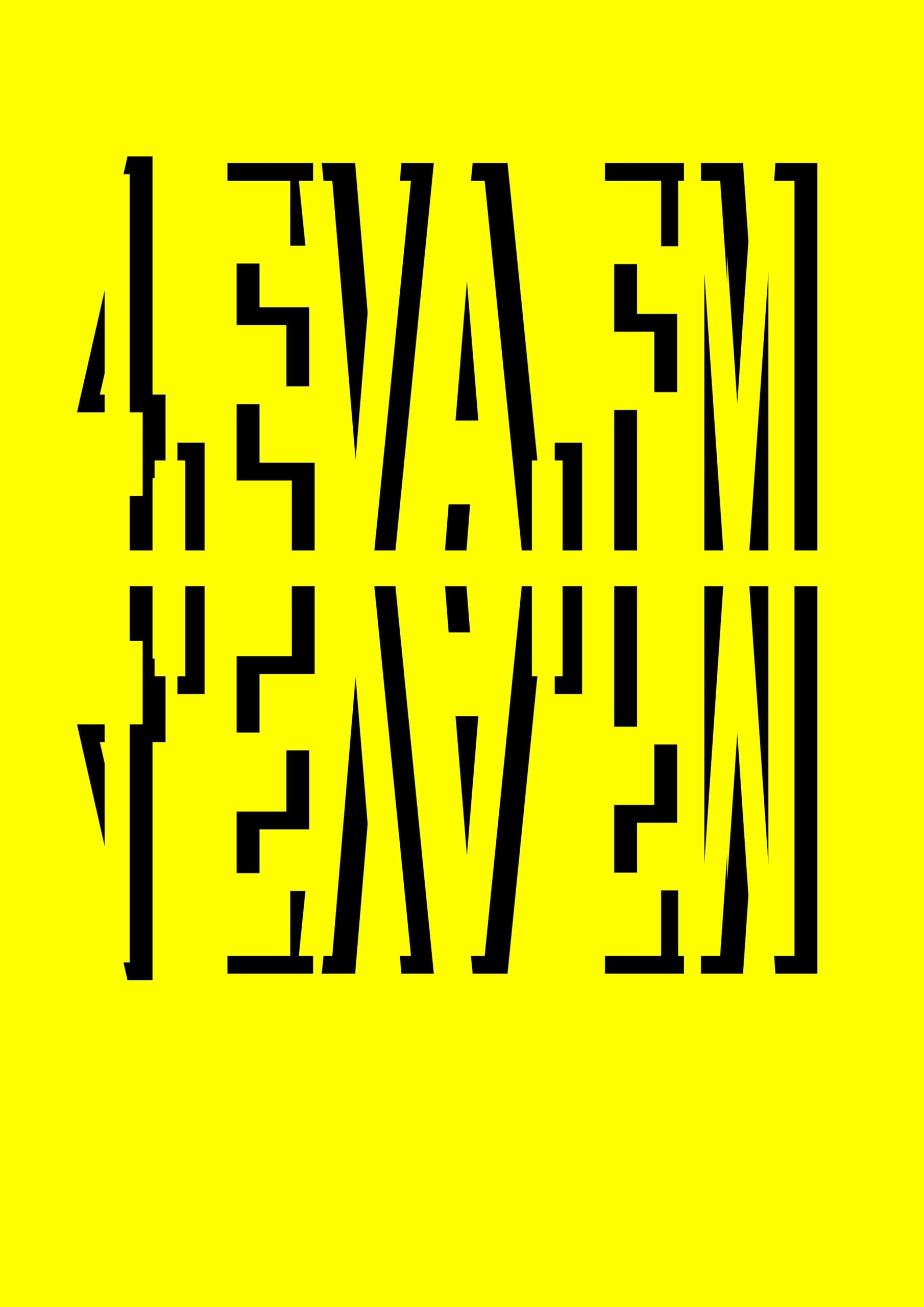
Both avid ravers and selectors themselves, Bridget and Debris somehow manage irreverence within generosity and goofy sincerity. Putting pirate radio in dialogue with rave culture and using the gallery space as an ad hoc research lab, 4.Eva.FM offers a mode of transmission that embraces diy illegality, collectivity and rapture. Radio is in essence disembodied; a total removal of the sound from its source and the voice from its body. Radio artist Gregory Whitehead names the history of radio art as a ‘history of nobodies,’ because the radio artist has always ‘found themselves vacated, (or vacated themselves), from the radiophonic space’.2 But in some ways, this disembodiment amplifies the potential for complex spatial and relational dimensions: ‘In transmissional space the object [is] ostensibly replicated in itself as it [is] transported over an equivalent distance'.3 In this sense, disembodiment refers to an object or body that exists in two or more places at once. Consider the relations between transmitter and receiver; between listeners themselves, known or unknown to each other. We might imagine this like stitching ‘collective conductive maps of [...] sound makers’ or an ‘electrified play of bodies’.4 Transmission situates ‘objects and bodies in inharmonic, noisy, and terrestrial relations without consuming their autonomy,’.5 The rave!
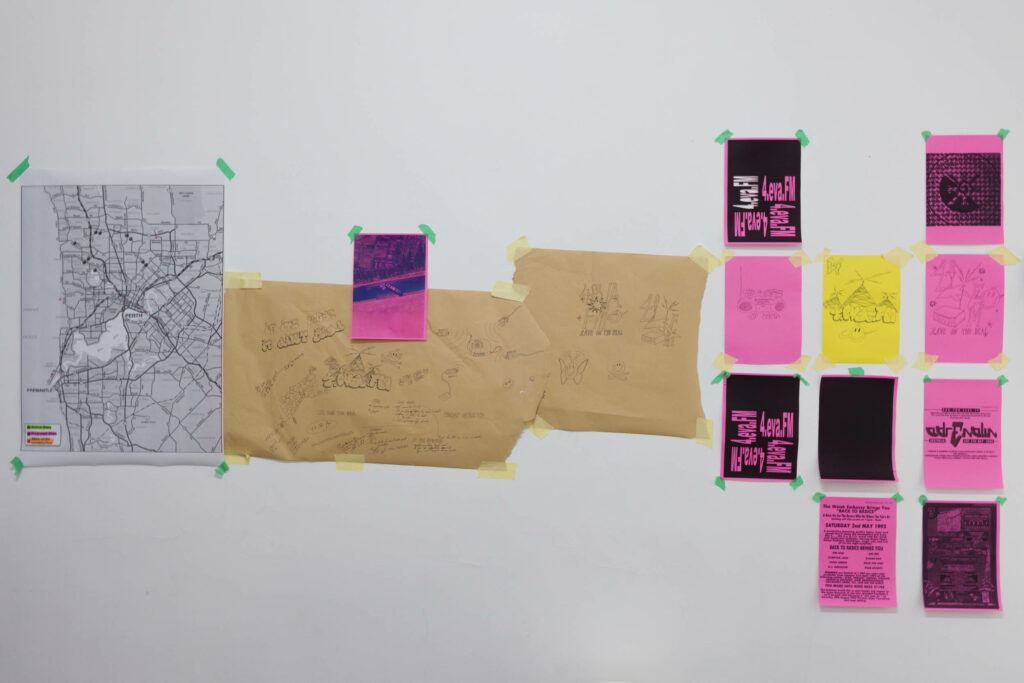
Bridget Chappell & Debris Facility, 4.Eva.FM. Residency at Cool Change Contemporary, June 2022. Photo courtesy of Jack Ball.
Pirate radio culture reminds us there are openings outside and between discrete commercial frequencies and their ‘ceaseless cacophony of agitated sales pitches [and] pop-song patter’. It asks
what kind of radiophonic relationships might we sustain across time if we think of radio as more than point-to-point communications on a licensed frequency? Listening across the spectrum yields a radically different impression than the visual charting of it: frequencies are not discrete, but noisy as well as harmonic, overlapping one another and full of fluctuation, interference and dynamic activity. Declaring ownership over such oscillating territories perpetuates the relentless functions of colonialism that have consistently worked toward conquest rather than collaboration or custodianship.6
Like seeing only the weightless glimmer of dust in sunlight and imagining that such glimmering does not happen between the beams, we cannot make-un-believe that whatever happens outside of commercially licensed allocations is useless or even for us. What lies in-between the stations is the real magick: half-heard chthonic mumbles; cascading stutters; whistles and roars; an audible translation of ‘the universe going about its [...] business’.7 What a kind of blessed respite, to know that the electromagnetic field does not care whether or not we keep broadcasting.
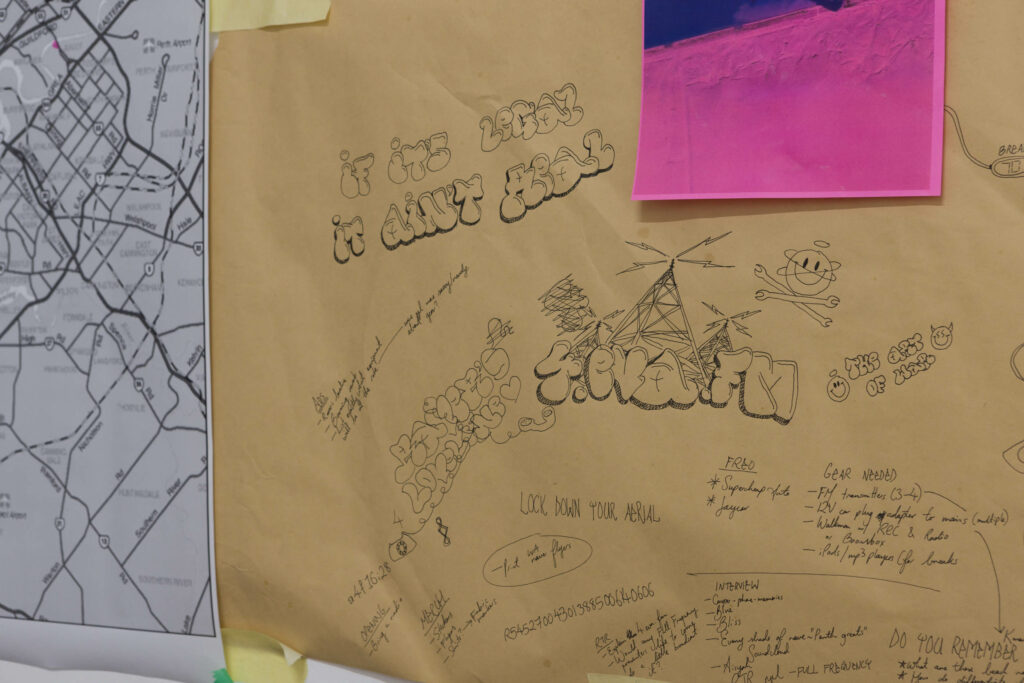
Bridget Chappell & Debris Facility, 4.Eva.FM. Residency at Cool Change Contemporary, June 2022. Photo courtesy of Jack Ball.
‘What is your ideal rave?’
'Like ... what do you mean?'
'Like. The best rave you could ever imagine. What's there, who's there? Where? You know.'
Des elaborates haltingly:
'Uh, it's outside.
All my friends are playing.
No bros.
No thoughts just — only feelings and
I don't know like
just that you're in your body but
not in your body
yr in the space
yr in the world'8
Over the phone, we begin in the tangible imaginable quantifiable and end someplace that language can’t reach. Can we reach it? We’re not sure, but we stretch (insistently) towards that place. In Latin, ad tendere, ‘to stretch towards’, is the origin for what we now call ‘attention’.
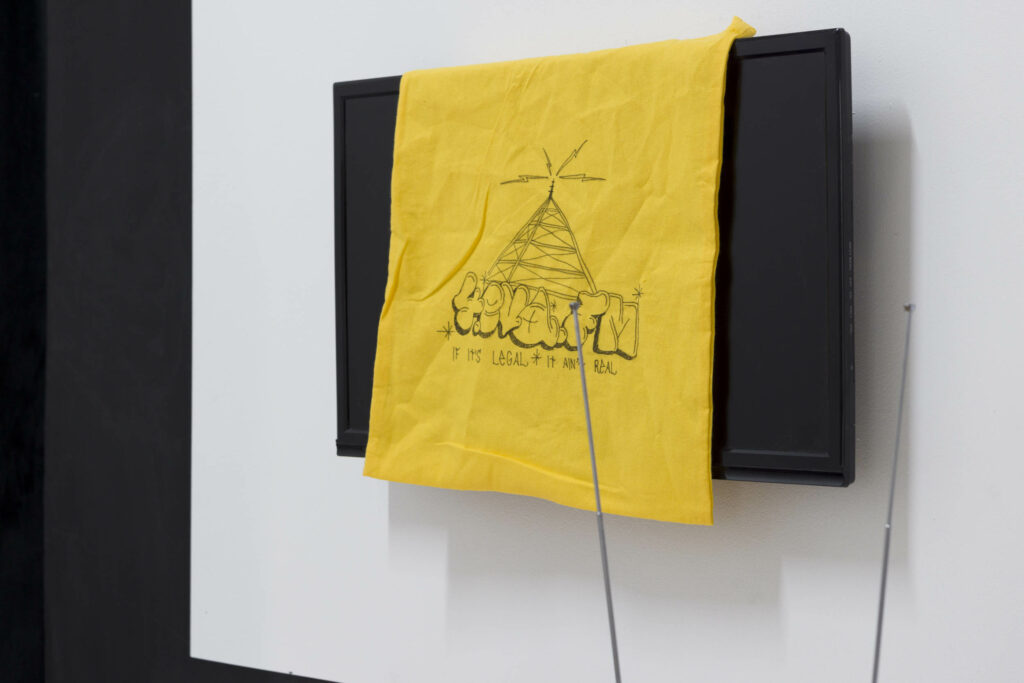
Bridget Chappell & Debris Facility, 4.Eva.FM. Residency at Cool Change Contemporary, June 2022. Photo courtesy of Jack Ball.
Having considered the question above, as Bridget and Debris invited us to do, I think my ideal rave is always the one that is yet to be, just as queerness, as proposed by José Estevan Muñoz, ‘is primarily about futurity and hope. That is to say that queerness is always in the horizon.’ My ideal rave is something in the air, like those glimmerings, hisses and stutters. Potentiality takes shape in the present but does not yet exist in the present tense, it is ‘a mode of being and feeling that [is] not quite there but nonetheless an opening.’9 We stretch towards the rave through that opening of potentiality, yearning and always becoming. ‘Where sound, body, and space meet, new dimensions of, and sensitivities towards, environments can develop, and our relationship to these environments can be re-imagined and transformed.’10
Franco Berardi, when writing about the circulation of information, makes a distinction between what he calls connectivity and sensitivity. Reinterpreted by Jenny Odell,
connectivity is the rapid circulation of information among compatible units, in this transmission of information, the units don’t change, nor does the information. [...] Sensitivity, in contrast, involves a difficult, awkward, ambiguous encounter between two differently shaped bodies that are themselves ambiguous—and this meeting, this sensing, requires and takes place in time.11
Allegorically, the rave sinks from an astringent, wordless potential to the punishing monologues of gurning bros. Another allegory; The “fucking RAVERS” Let Zuck Infiltrate The Sacred. It was a f*cebook group chat that began one night out in order to keep track of each other’s movements. On this first night, it was only a handful of us, whoever was in attendance at this particular event. A group chat felt like collectivity and shared attention, as well as a practical solution to becoming separated. In the weeks following the event, friends and friends of friends’ friends were added to the group, billowing into something that demanded immediacy and urgency without context or adhesion. People shared links to upcoming dance music events as readily as they dropped unsolicited cat pics and complained about the Grill’d work roster. While I fend off suggestions of purchasing tix to Outer Body I spiral into the ungraspable smooth of those tiny circular profile pics. Our miniscule DPs are disembodied, dismembered and decapitated — no rave heads, no rave bodies, no-body here at all.
I duck out of the group leaving my mobile digits, an amiable excuse, and an oily whiff of hope: that we might still imagine transmission as noisy, inharmonious, messy and flailing. Isn’t that the promise of the ‘fucking RAVE’? Meeting and sensing in time and place? An invitation to attune to an unpredictable oscillation with a curious finger on the dial’s pulse? ‘Utopian feelings can and regularly will be disappointed. They are nonetheless indispensable to the act of imaging transformation’.12
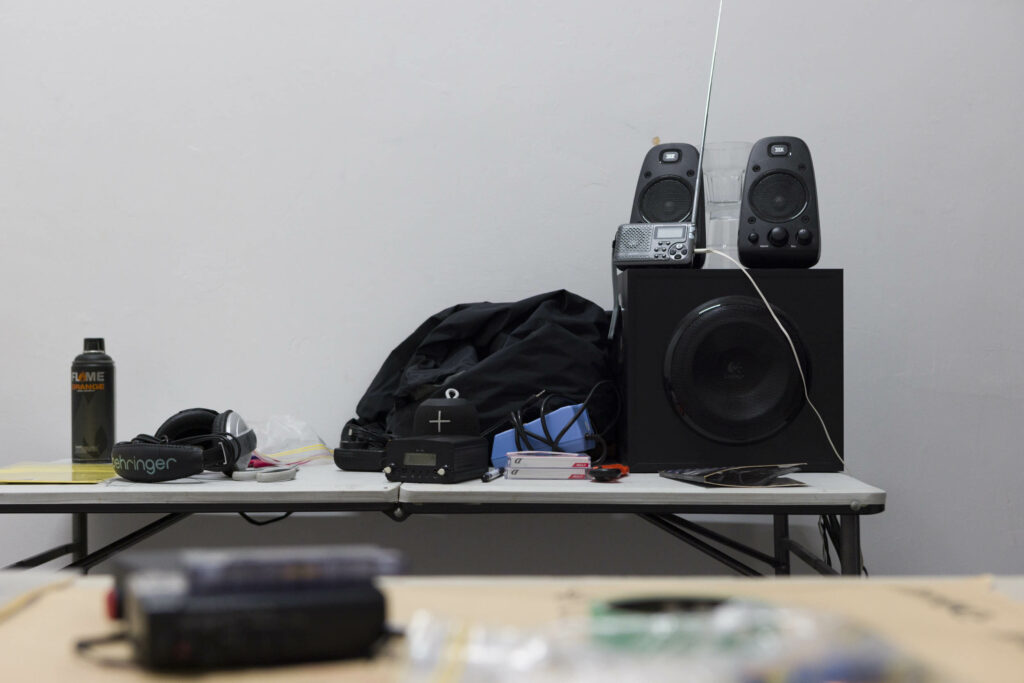
Bridget Chappell & Debris Facility, 4.Eva.FM. Residency at Cool Change Contemporary, June 2022. Photo courtesy of Jack Ball.
Getting ready to leave Cool Change Contemporary gallery space for the last time before Debris flies out, I ask them what happens now?
‘I guess … it keeps going. Without us.’
In Boorloo, in Naarm? In the radio? Which — in mine or yours? In between? Every point particle speck of air that falls under the cast, everywhere but nowhere at once, duplicated, multiplied, coinciding in all potential positions, which puts me in every potential position and relation to you; our proximity is intimate and far-flung, I am right beside you, I am in you I am entering you, as my voice reaches you and your ears receive that flutter of air, as we are bodies across from one another, meeting and sensing in (a) time and (a) place.
Annika Moses is based in Boorloo (Perth) on unceded Whadjuk Noongar boodjar. She likes to listen to and think about the radio and sound. She also likes to make radio and sound (as Annika Moses, Nika Mo, Great Statue, in Didion's Bible, in Tone List and on RTRFM 92.1).
un Projects’ Editor-in-Residence Program is supported by the City of Yarra.
